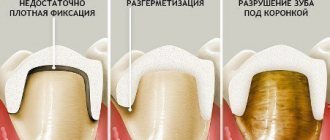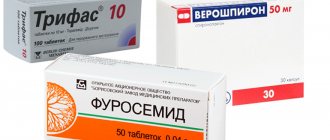Edema is a condition in which excessive amounts of fluid accumulate in certain organs or intercellular spaces. Swelling of the legs is especially common, since the lower extremities are constantly exposed to increased stress. The fluid is mainly localized in the area of the legs and feet.
Swelling can occur on one limb or on both. They usually appear in the evening.
What is leg swelling
Swelling of the legs is an external manifestation of the accumulation of fluid in the body. At the same time, the limb itself noticeably increases in size, the skin on it becomes loose, and when pressed, dents appear that do not disappear instantly.
Swelling usually occurs in the evening, although it can still cause discomfort the next morning. It is localized:
- in the feet;
- in the ankles;
- in the legs;
- from socks to knee.
Depending on the reasons, either one leg or both may swell. Symmetrical distribution often indicates generalized edema, which may be a symptom of a life-threatening condition.
If this trouble appears rarely, then you can fight it with folk remedies. The regularity of occurrence indicates a disease of the internal organs. Therefore, it is important to establish the nature of the swelling.
Treatment
There are many ways to quickly solve the problem, but the result is temporary. To get a stable effect, it is necessary to establish why the legs swell and eliminate the cause of the pathology.
Conservative therapy
If your legs swell very much, your doctor will tell you what to do. He will select medications depending on the cause of the problem.
For pathologies of the kidneys and heart, diuretics and antihypertensive drugs, immunosuppressants are prescribed, and hemodialysis is performed according to indications.
For varicose veins, the doctor selects phleboprotectors or venotonics. These drugs strengthen the veins and normalize venous circulation. Special ointments and compression garments will help relieve unpleasant symptoms.
For heart diseases, diuretics, vasodilators, adrenoblockers, ACE inhibitors, glycosides, and anticoagulants are selected.
For joint diseases, non-steroidal anti-inflammatory drugs (in the form of ointments, tablets, injections), physical therapy, massage, and physiotherapy are recommended. In case of fractures and dislocations, a plaster cast is applied or skeletal traction is used. Additionally, analgesics, massage, and physiotherapeutic procedures are prescribed.
Local infections are suppressed with antibacterial, antiviral or antifungal drugs.
Lymphatic drainage massage provides a good effect. It activates metabolism and lymph flow, which eliminates puffiness. Additionally, therapeutic and compression therapy, taping, osteopathy, and manual therapy are recommended. Physiotherapeutic procedures improve local blood circulation, relieve inflammation and pastosity.
Surgery
If conservative treatment does not have the desired effect for swelling of the legs, surgical intervention is recommended:
- For heart pathologies: o pericardiectomy – the pericardium is removed; o interventions on valves, partitions, chambers; o radiofrequency ablation; o implantation of a pacemaker.
- For vascular diseases: o sclerotherapy; o phlebectomy; o thrombectomy; o thrombolysis; o laser coagulation; o EVLO; o RFO; o bypass surgery; o tunneling.
- For kidney damage: o organ transplantation.
- For joint diseases: o arthroplasty; o arthrodesis; o endoprosthetics.
- For traumatic injuries: o plastic surgery of ligaments; o osteosynthesis; o meniscectomy.
- During purulent processes: o opening of abscesses, phlegmons, boils, carbuncles; o arthrotomy; o sequestrectomy.
Causes of leg swelling
When there is too much fluid in the tissues, it means that there is a malfunction in the functioning of the body. Most often, swelling is caused by:
- protein metabolism disorder;
- damage to cell membranes, increasing their permeability;
- changes in pressure differences in tissues and vessels;
- impaired blood circulation.
There are many reasons for such failures. Some are temporary (allergic reaction, bruise, infection). Others indicate the development of pathologies of the lower extremities (varicose veins, thrombophlebitis). Still others indicate serious diseases of the internal organs (heart, kidneys, lymphatic system).
A person cannot independently determine why his foot is swollen: because of uncomfortable shoes or because of a blocked blood vessel. Therefore, you should not postpone a visit to the doctor for subsequent treatment.
Other reasons
The answer to the question “Why do my legs swell and how to deal with it?” People suffering from:
- endocrine pathologies (myxedema, hypothyroidism, hyperaldosteronism, Ishchenko-Cushing's disease);
- exhaustion (anorexia nervosa, nutritional cachexia, severe weight loss after serious illness or surgery);
- nervous disorders (paresis, paralysis).
In the above cases, the edema is mild or moderate, symmetrical (with the exception of unilateral paralysis), soft. They do not change during the day, occasionally increasing in the evenings.
- Allergic reactions Under the influence of allergens, fluid rapidly accumulates in the tissues, which leads to instant swelling of the legs. In this case, the skin becomes red in color and itching appears.
- Obesity Due to excess weight, pressure on the lymphatic vessels and veins increases, which leads to disruption of lymphatic and venous outflow.
- Taking medications Some medications (vasodilators, antihypertensives, antidiabetics, calcium channel blockers, nonsteroidal anti-inflammatory drugs) can cause swelling of the lower extremities.
Why does one leg swell?
If the swelling is asymmetrical, its cause is localized directly in the affected limb. Swelling may occur due to bruises on the legs or more serious injuries:
- ankle joint injuries;
- meniscus tear;
- separation of the calf muscle;
- bone fracture;
- tissue compression.
Venous edema is also most often unilateral. Varicose veins cause fluid stagnation, but they are localized in one limb where the vessels are affected. This is indicated by the characteristic venous network.
Thrombophlebitis disrupts blood circulation, and at the same time the outflow of fluid from tissues. In this case, swelling is accompanied by other unpleasant symptoms: fever, pain, compaction in the blockage area.
Is there swelling on the face due to heart disease?
Yes, these questions usually worry women, says cardiologist Andrei Grachev.
They run to see a cardiologist when they can’t put a ring on their finger in the morning because it’s swollen or put on makeup because their face is swollen. The patient wants to look great, regardless of age and health status. And this is commendable. Men, as a rule, do not contact a cardiologist with such questions. The peculiarity of this issue is due to the fact that in patients with cardiovascular diseases, as a rule, swelling on the face appears at the final stage of a complication such as heart failure. First, they appear on the legs (the lowest point in relation to the heart), then fluid accumulates in the abdominal cavity, the liver and spleen enlarge (as a blood depot). And only after the fluid reaches the pleural cavities and the heart sac, swelling may occur on the face or hands.
Why do both legs swell?
If by the end of the day both lower limbs are swollen, it means that excess fluid is present throughout the body. Most often this condition is caused by:
- heat;
- excessive fluid intake;
- obesity;
- uncomfortable shoes (tight, high heels, completely flat soles);
- flat feet;
- unhealthy diet (lots of salty and spicy foods in the diet);
- standing on your feet for a long time or in an uncomfortable position.
Fluid stagnation in these cases is caused by improper load distribution. None of the above indicates a threat to life, and the swelling goes away in a day or two. For some, it is enough to take off their shoes and relax, while others resort to folk remedies to relieve discomfort. But symmetrically swollen legs can also indicate more serious diseases that require urgent treatment.
Root causes of swelling
The accumulation of excess fluid is associated with a disruption of the system responsible for its distribution and removal from the body. For healthy people, predisposing factors for an abnormal condition are presented:
- prolonged stay in a statistical position - standing or sitting;
- injuries, strength training;
- wearing high-heeled shoes;
- metabolic dysfunction during pregnancy;
- overweight or obesity.
The accumulation of fluid indicates a strong load on the venous vessels. The patient needs to prevent venous diseases; in the evening he should rest, with the lower limbs raised above the level of the head. He is prohibited from lifting weights, orthopedic shoes, weight loss, walking and cycling are recommended.
Swelling in the legs reports:
- about heart failure - with discomfort in the lumbar region, high blood pressure, problems with urination;
- pathologies of bones and joints - characterized by painful sensations in the legs, limited movement of the articular apparatus;
- diseases of the nervous system - accompanied by movement disorders, problems with speech and coordination of movements, decreased tactile sensitivity, convulsions, headaches and insomnia;
- CVI and varicose veins are determined by swelling that appears in the evening and disappears in the morning, stars on the legs, blue, tortuous veins, dry and shiny skin with brown pigmentation (in the future they will degenerate into trophic ulcers).
Tissue swelling can be primary or accompany another disease. It is impossible to cure the problem without consulting a doctor.
When general swelling indicates danger to life
Sometimes swelling of the lower extremities is a symptom of a general imbalance in the body's hydrobalance. In the case of heart failure, the body's main muscle cannot cope with pumping blood. The fluid in the body is distributed unevenly, and too much accumulates at the bottom. If the patient stands or sits in one position for a long time, his feet and legs swell.
Kidney failure can also lead to swelling. It appears not only on the legs, but also on the arms, face (mainly under the eyes), and abdominal wall.
If cardiac edema develops gradually (over weeks), then renal edema develops very quickly. With cardiac diseases, the skin becomes colder, with kidney diseases it maintains a normal temperature.
Fluid retention can also be caused by lymphedema, which is damage to the lymphatic vessels. The swelling in this case is dense; after pressing on the skin, there is no indentation.
Pathological causes
Quite often the legs swell in people with health problems.
Swelling is a symptom that accompanies:
- Traumatic injuries When injured, the skin usually becomes bluish or purple, abrasions and bruises appear, and the tissues become swollen. In case of injury, the swelling is always one-sided, located at the site of injury, and can spread to nearby tissues. Swelling of the limb is possible with bone fractures, dislocations, ligament damage, meniscus tears, severe bruises, burns, frostbite.
- Purulent processes With purulent lesions of the skin, soft tissues, bones, joints, dense swelling is localized in one place, quickly increasing in size. It is combined with redness or cyanosis of the skin, jerking pain, and signs of intoxication of the body.
- Kidney diseases Due to malfunctions of the kidneys, their filtering abilities are impaired and the tubules are damaged. As a result, the kidneys do not have time to remove fluid from the body, which is why it moves from the blood vessels into the tissues, which causes swelling of the feet and legs. In this case, the swelling is symmetrical, soft, watery, and elastic. In addition to the legs, they cover the arms, stomach, and face. They appear very quickly, often in the morning. An additional symptom is yellowing of the skin. Most often, the lower extremities swell with nephritis, pyelonephritis, glomerulonephritis, renal amyloidosis, nephrosis, membranous nephropathy, chronic renal failure.
- Pathologies of the heart and blood vessels In diseases of the cardiovascular system, edema is symmetrical and dense, pasty ankles and feet may be observed. Occasionally, swelling completely covers the lower leg, reaching the knees. In this case, swelling appears and resolves very slowly (within several weeks), the skin acquires a bluish tint and becomes cool. Most often, swelling of the legs is evidence of the initial stage of varicose veins. In this case, the swelling is accompanied by pain and heaviness in the lower extremities. Later, other signs appear - convulsions, protruding veins. In healthy people, due to the contraction of the muscles in the legs, venous blood moves from bottom to top. Venous valves prevent blood from flowing in the opposite direction. With varicose veins and thrombophlebitis, the functioning of the valves is disrupted, which is why blood begins to move in two directions. At the same time, it stagnates in the veins, which leads to increased venous pressure, thinning of the vein walls, and loss of tone. As a result, the permeability of the vessels increases, the fluid from them moves into the surrounding tissues, causing swelling. In addition, due to stagnation, the blood thickens, which increases the risk of blood clots. Swelling can be a symptom of thrombosis, cardiomyopathy, cardiosclerosis, cardiac amyloidosis, arterial hypertension, postthrombophlebitis disease, arrhythmia, constrictive pericarditis, heart failure. Due to impaired lymph outflow, edema can occur due to lymphostasis, lymphedema, removal of lymph nodes, or compression of lymph vessels by tumors. In this case, the swelling is one-sided, very dense and persistent. When pressing with a finger, a dent does not form.
- Joint diseases A common cause of swelling of the ankle and knee joints is arthritis (rheumatoid, psoriatic, gouty, reactive, infectious) and arthrosis. In arthritis, swelling can be symmetrical and asymmetrical, unilateral and bilateral. It is combined with pain, hyperthermia, local hyperemia, a feeling of stiffness, and limitation of movements. With arthrosis, swelling is almost invisible, intensifying during periods of exacerbation.
- Metabolic disorders A common cause of swelling is metabolic disorders (for example, diabetes mellitus). The problem is aggravated in obese people, whose lower limbs are subject to increased stress.
Why do feet swell during pregnancy?
During pregnancy, the outflow of fluid is often disrupted. This is explained by large-scale changes occurring in the body:
- weight gain;
- changes in hormonal levels;
- compression of the inferior vena cava by the enlarging uterus;
- decreased mobility;
- diet correction.
In most cases, swelling is considered as a variant of the physiological norm. There is no need to resort to drug treatment; it is enough to keep the situation under control. However, the spread of edema throughout the body can result in serious pathologies, such as preeclampsia.
The expectant mother should monitor the dynamics of the increase in calf circumference, blood pressure and the ratio of fluid consumed and excreted. The kidneys experience increased stress during pregnancy, so at the first alarming symptoms it is better to be examined by a nephrologist.
Recommendations
To achieve and maintain the effect, the action plan, in addition to the main therapy, may include compliance with certain lifestyle recommendations. These include: • Do not sit for a long time in one position with your legs tucked. • Change shoes frequently (at least 1-2 times throughout the day). • Periodically massage your feet using rubbing or pinching movements. • Balance your diet by adding foods with potassium and reducing your intake of sodium-rich foods. • When sleeping, place a special cushion or a regular pillow under your shins so that your lower extremities are above the level of your heart. Before going to bed, you need to raise them and keep them in this position for 5-10 minutes to relieve accumulated fatigue and tension. • In the early stages of varicose veins, physiotherapy, diet therapy and physical therapy are very useful, which can only be done under strict medical supervision.
Unfortunately, with an advanced disease, it is not possible to limit yourself to just lifestyle changes or physical activity - edema requires therapy. Therefore, you need to consult a doctor in a timely manner, preferably at the earliest stages of the development of the pathology, so that all the unpleasant sensations in the legs go away and your gait becomes light and relaxed again. Then the treatment will be effective, and the chances of a full recovery will be as high as possible.
Similar articles:
- Directions
- Specialists
- For visitors
- Articles and videos
“Healthy Summer” 1000 rubles discount on an appointment with osteopathic doctor E.A. Ukhmylin.
Adult admission 6 thousand, children admission 5 thousand.
Treatment of leg swelling
The treatment package depends on the cause of the unpleasant symptom. If it is not associated with serious diseases, but is caused by improper distribution of the load, it is enough to locally relieve the swelling. This can be done at home.
If it is caused by local reactions (bruise, allergy, infection), then it is necessary to provide the victim with the necessary assistance:
- treat the damaged area;
- apply ice;
- give medicine.
Sometimes this can be done at home, sometimes medical attention is required. After a few days, the swelling will disappear as the tissue heals.
Drug treatment under the supervision of a phlebologist is required for varicose veins and thrombophlebitis. If the disease is advanced, surgery may be required. After restoration of venous tone and normal blood circulation, external symptoms will disappear.
How to save your feet from swelling
We talked about the reasons for the appearance of edema and what needs to be done to restore health to the legs with the head of the department of lymphology and chronic venous insufficiency of the Phlebology Center clinic, phlebologist surgeon Evgeniy Sergeevich Silchuk.
— Let’s say that in the evening young women’s legs swell and hurt, what is behind this? — Most likely, leg problems arose due to a sedentary lifestyle. It is also very important what kind of shoes a woman wears. For example, doctors do not recommend regularly wearing shoes with heels higher than 5-6 centimeters. The fact is that the outflow of blood and lymph from the legs is carried out mainly due to the contractility of the calf muscles. If the muscles are toned, there will be no stagnation, which means there will be no swelling.
When a woman walks in high heels, the calf muscles practically do not contract, resulting in swelling. It will be especially noticeable in the evening, when a woman comes home and takes off her shoes. My legs are buzzing... I want to stretch out on the sofa and put my feet on a raised platform.
- Will this help? “I once came across a popular article about a healthy lifestyle, where the author advised raising your legs up for fifteen minutes at the end of every hour. Of course, few people can afford this, but it is really very useful. The so-called postural drainage occurs when blood and lymph flow out of the swollen legs under their own weight.
There are simpler, but equally effective methods. For example, you can step from toe to heel and back several times in a row, stretching the muscles of your lower leg.
— Probably, it’s also useful to walk up the stairs? - Undoubtedly. For example, I always recommend to my patients not to stand on the escalator in the subway, but to walk up. But going down the stairs is not at all so useful - because each such step gives a hydrostatic shock to the blood vessels, as with step aerobics. However, this does not mean that you should not go down stairs at all, it’s just that going up is much more useful.
— Evgeniy Sergeevich, what sports will help get rid of edema? — I strongly recommend everyone to engage in water sports, primarily water aerobics: on the one hand, a person moves a lot, getting good physical activity, on the other hand, water puts pressure on the skin, preventing blood vessels from dilating and legs from swelling. Swimming is very useful, especially in sea water. All dynamic sports have a good effect - running, skiing, cycling, skating, and even simple walking.
In general, I believe that, unless there are contraindications, any person should walk at least three to five kilometers a day.
- What should you not do? — Those sports that often lead to injuries are harmful: alpine skiing, snowboarding... Yes, the same football! Weightlifting can cause even more harm.
It is clear that many people want to keep themselves in good shape and go to the gym to do this. However, the passion for strength training and weight lifting can play a bad joke on them. During such exercises, the abdominal muscles contract, and intra-abdominal pressure increases, passing to the inferior vena cava, one of the most important veins in our body, which collects blood from the pelvis and lower extremities. All this leads to poor blood flow. Therefore, I recommend that everyone who still wants to exercise on such simulators must wear high-quality compression hosiery during classes.
By the way, static sports, for example, yoga with stretching, are not very useful. Such activities are not very good for blood vessels.
— Very often pregnant women complain of edema. Why do they have problems with their legs? — Pregnancy is a very difficult process. A woman’s body undergoes serious changes in the pelvic area, in particular, the uterus enlarges, which begins to put pressure on large vessels located around. As a result, blood circulation deteriorates, which leads to swelling.
The hormonal changes that occur in the female body during pregnancy are also important; they also often lead to edema.
— What should pregnant women do who want to avoid such problems? — Women usually complain about edema in the early stages of pregnancy. I can tell you what we do in our clinic. First of all, we carry out a comprehensive diagnosis. It is clear that there is no talk of any radical treatment procedures if there are no serious complications. We recommend only preventive measures.
After diagnosis, when it becomes clear what problem we are dealing with, therapeutic knitwear is usually prescribed. If the swelling is severe, we recommend wearing it almost every day. Today this is the most effective remedy for the prevention of edema and varicose veins in pregnant women.
— What about exercises for the calf muscles? — If it concerns a pregnant woman, any additional physical activity must be discussed with a gynecologist, cardiologist, or therapist.
— We were talking about practically healthy people, but edema can also be a symptom of some disease? - Yes it is. The appearance of edema may indicate problems with the kidneys, heart, lymphatic vessels, etc. Quite often the reason lies in varicose veins. And in all these cases, exercises and compression stockings alone are not enough—full-fledged diagnosis and adequate treatment are necessary.
- There are also special ointments for edema... - Most of these ointments have not a therapeutic, but a preventive effect. They can improve blood microcirculation and venous outflow, but will not remove the root cause of edema.
— That is, if a woman’s legs begin to swell a little in the evenings, should she rush to the doctor? — Personally, I believe that if problems arise, you should always seek advice from a specialist. First of all, see a phlebologist.
Prevention is always better than cure. Recently, for example, at one scientific congress, my French colleagues told how they conduct clinical examinations of young people. All girls who undergo a medical examination are asked if any of their family members have varicose veins. And if the answer is yes, then the doctor will definitely recommend that they use compression stockings for prevention. At the same time, he talks about the causes of vein disease, explains how to behave correctly, and how to take care of the health of your legs.
Unfortunately, in our country it is customary to consult a doctor only when the thunder has already struck. What kind of prevention can we talk about here? But the development of preventive medicine largely depends on the consciousness of patients.
- And yet, what should tell a person that it is no longer possible to delay a visit to the doctor? - If the legs swell systematically, if the swelling that appears in the evening does not subside by the morning, if other unpleasant symptoms appear simultaneously with the swelling. Or if your legs swell very much.
- What does severe swelling mean? — Severe swelling of the legs is the main symptom of a very serious disease called lymphedema. Its essence: disruption of the normal outflow of lymph through the lymphatic vessels). If swelling that occurs in the evening does not disappear by the morning, if the skin begins to change in places of swelling, then there is a high probability that the person has lymphedema and should urgently contact a specialist.
- Is this curable? — Lymphedema requires complex therapy, and in Russia there are not many centers that deal with such problems. However, in our clinic we have been able to achieve significant success, so that now patients from abroad even come to us for treatment.
— Evgeniy Sergeevich, when you talked about edema, did you mention women more often, but do men’ legs swell less often? - Edema occurs in both women and men. This is not a disease, but a signal of trouble in the body, and what exactly the problem is should be understood by specialists. In any case, waiting for everything to somehow “go away on its own” is unacceptable.
How to relieve swelling after a bruise
Treatment for a leg bruise usually comes down to eliminating pain and swelling. The swelling in this case is caused by damage to the blood vessels and the accumulation of fluid from them under the skin. The latter puts pressure on the nerve endings, hence the pain. So eliminating swelling also helps to get rid of unpleasant sensations.
You can help a bruised limb at home:
- stretch and provide peace;
- apply a wet towel, ice or a heating pad with cold water;
- apply a tight bandage.
You can also resort to drug treatment. External agents containing troxerutin or heparin will help. They strengthen capillaries, optimize blood viscosity and relieve inflammation.
Classes of diuretics and indications for their use
Main indications for the use of diuretics of various classes
| Diuretic class | Indications |
| Osmotic | Edema of the brain, lungs, acute attack of glaucoma, barbiturate poisoning |
| Carbonic anhydrase inhibitors | Edema due to pulmonary heart failure, glaucoma, epilepsy |
| Loop | Hypertensive crisis, cerebral edema, chronic renal failure, poisoning with water-soluble poisons |
| Thiazides and thiazide-like diuretics | Hypertension, cardiovascular failure, liver cirrhosis, nephrosis, pregnancy nephropathy, glaucoma |
| Potassium-sparing | Hypertension, heart failure, liver cirrhosis, hypokalemia during treatment with diuretics of other groups |
| Vegetable | Renal edema, whistitis, chronic renal failure |
| Xanthine derivatives | Hypertension, heart failure (in complex therapy) |
How to relieve leg swelling caused by heat
The best medicine in this case is gravity. Arriving home and throwing away the shoes that have become a vice, it is enough to lie down and place your feet higher (at a minimum - on several pillows, at a maximum - against the wall).
When it becomes easier to move, you need to take a shower. Ideally, a contrasting one that trains blood vessels, but you can limit yourself to just cool. In this case, you should direct the pressure to the feet: such a hydromassage will restore blood circulation.
You can disperse the fluid with light exercises: pulling the toe towards you and away from you, rotating your feet, squatting. But if you don’t have the strength to do this, and your legs hurt, it’s better not to torture them.
Foot baths are also useful. Even plain water will provide relief, but you can enhance the effects with additives. This could be sea salt or herbal infusions. Compresses made from cabbage leaves or bandages soaked in a decoction of birch leaves improve the condition of the limbs.
Treatment of leg swelling due to heart or kidney failure
Patients with heart or kidney failure should be under the supervision of a physician. In acute attacks, resuscitation is required. If the disease takes a chronic form, swelling is removed as it appears with the help of diuretics and nutritional correction. Medicines should:
- stabilize blood pressure;
- remove excess sodium from the body;
- prevent protein loss;
- normalize blood flow speed.
When using diuretics (diuretics), it is important not to exceed the permissible dosage. Otherwise, there is a risk of getting the opposite effect in the form of drug-induced edema during withdrawal. They are caused by the kidneys’ reaction to a sudden change in the mode of fluid excretion.
Important!!!
{jb_warning}The appearance of swelling in the legs is in any case a sign of the emergence and development of serious problems in the body, so you simply need to seek advice from a highly qualified specialist. Under no circumstances should you just wait for the swelling to go away on its own and, of course, not self-medicate. It is important to go through all the necessary diagnostic procedures and only then begin the process of eliminating the problem, already knowing the root causes.{/jb_warning}
If you have the following symptoms:
- constant severe swelling of the legs;
- the occurrence of swelling in the evening, which does not subside in the morning;
- in addition to edema, symptoms such as night cramps, skin changes in areas of edema, and trophic ulcers appeared.
It is imperative to consult a doctor. Remember, not treated in a timely manner can lead to complications, even death. This, for example, can occur during acute deep vein thrombosis, when the forming blood clots can break off and pass into the “large” bloodstream, thereby causing blockage of blood vessels, including the pulmonary artery.
In our multidisciplinary medical center you will always receive highly qualified care. For you - a wide range of diagnostic procedures with subsequent treatment of the disease. We use only the most modern equipment. We are responsible for each of our patients.
Relieving swelling during pregnancy
In the body of a woman carrying a fetus, the concentration of the hormone progesterone increases. It is one of the causes of edema during pregnancy. In no case should it be reduced, because it is this that ensures the attachment of the embryo.
There is no need to fight physiological swelling. The main thing is to prevent it from getting worse. To alleviate the symptoms, you can carry out the mentioned water procedures and adhere to a healthy lifestyle (moderate activity, water consumption within the daily norm, adjusted for restrictions imposed by pregnancy, rest on your side).
The pathological nature of edema can only be determined by a doctor based on test results (in particular, protein in the urine). Having discovered the cause, he will prescribe treatment. It is prohibited to take any medications on your own.
Indapamide
This is a moderate-acting drug that is usually prescribed for edema associated with heart failure. "Indapamide" is quickly absorbed into the gastrointestinal tract. Diuretic tablets reduce the load on the heart and peripheral vessels and stabilize blood pressure. The effect occurs an hour after taking the drug and lasts 12-18 hours. You can buy Indapamide with a prescription, it is inexpensive, but it is a generic (not the original drug). Be sure to check the possible side effects.
Indapamide
OZON, Russia
Arterial hypertension;
sodium and water retention in chronic heart failure. from 8
771
- Like
- Write a review
Prevention
Swelling cannot always be prevented, since it can occur under the influence of uncontrollable factors. There is no way to prevent a bruise or insect bite. But in general, maintaining hydrobalance in the body is easy:
- Observe the drinking regime: fully quench your thirst, but do not drink more than you should.
- Stick to a diet during the hot season: minimize the consumption of salty and spicy foods, eat more fruits, drink tea with lemon instead of coffee.
- Arrange water treatments: contrast showers, foot baths.
- Move more: walking, swimming, aerobics do not allow fluid to stagnate.
In summer, you should avoid tight, high-heeled shoes. It is useful to periodically place your feet on an elevation so that fluid concentrated in the lower part of the body drains. There is no need to abuse medications. Urinary and antihypertensive drugs should be prescribed by a doctor. Any diseases that have a similar symptom must be treated in a timely manner.
Tokareva Lyudmila Georgievna, therapist, medical offices 36.6.
THERE ARE CONTRAINDICATIONS, BEFORE USE YOU MUST CONSULT WITH A SPECIALIST
Triampur compositum
This diuretic does not have a very pronounced effect and does not remove potassium from the body, only water, salts and toxins. That is why Triampur compositum is considered the safest diuretic drug, which is prescribed for edema due to chronic heart failure and liver problems. Triampur begins to act 15 minutes after administration, and the effect lasts about 12 hours. Doctors say that this diuretic is safe for relieving facial swelling, is quickly absorbed into the gastrointestinal tract, and has a gentle effect.
Triampur compositum
AVD.pharma, Croatia
-arterial hypertension;
—edematous syndrome of various origins (with chronic heart failure, nephrotic syndrome, liver cirrhosis). from 256
306
- Like
- Write a review









